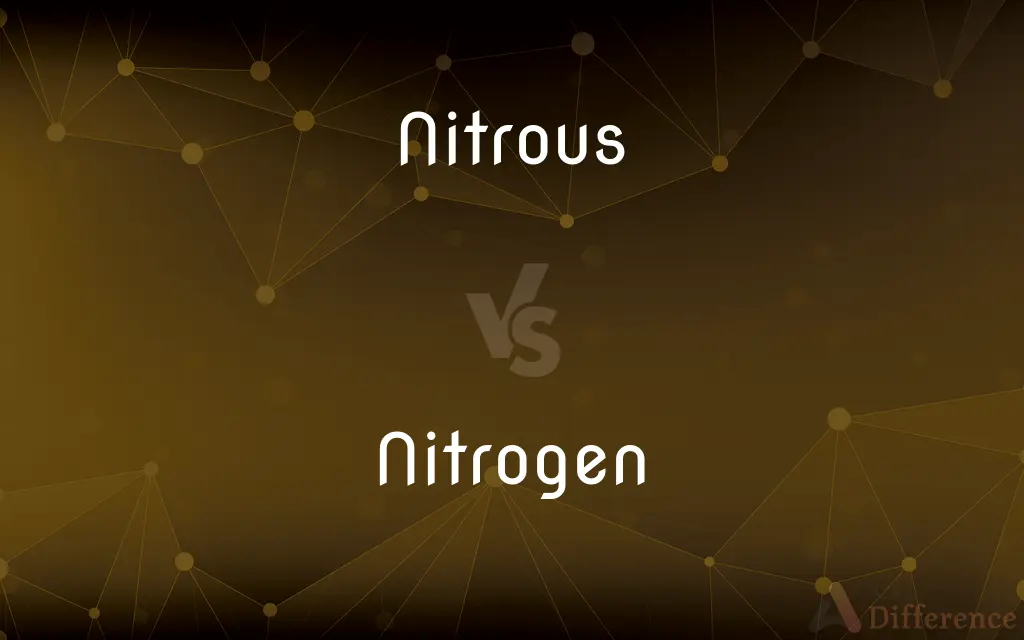Nitrous vs. Nitrogen — What's the Difference?

Difference Between Nitrous and Nitrogen
ADVERTISEMENT
Compare with Definitions
Nitrous
Of or containing nitrogen with a lower valency, often three.
Nitrogen
Nitrogen is the chemical element with the symbol N and atomic number 7. It was first discovered and isolated by Scottish physician Daniel Rutherford in 1772.
Nitrous
Of nitrogen; nitrogenous
The effect of nitrous emissions on acid rain
Nitrogen
A nonmetallic element that constitutes nearly four-fifths of the air by volume, occurring as a colorless, odorless, almost inert diatomic gas, N2, in various minerals and in all proteins and used in a wide variety of applications, including manufacture of ammonia, nitric acid, TNT, and fertilizers, and as a cryogen. Atomic number 7; atomic weight 14.0067; melting point -210.00°C; boiling point -195.80°C; valence 2, 3, 4, 5. See Periodic Table.
Nitrous
Relating to or containing nitrogen, especially in a valence state lower than that in a comparable nitric compound.
ADVERTISEMENT
Nitrogen
(uncountable) The chemical element (symbol N) with an atomic number of 7 and atomic weight of 14.0067. It is a colorless and odorless gas. Category:en:Nitrogen
Nitrous
Pertaining to or composed of nitre; having the properties of nitre, bitter.
Nitrogen
(uncountable) Molecular nitrogen (N2), a colorless, odorless gas at room temperature.
Nitrous
(chemistry) Of, relating to, or derived from nitrogen, especially in which the valence of the nitrogen is lower than that of a corresponding nitric species.
Nitrogen
(countable) A specific nitrogen atom within a chemical formula, or a specific isotope of nitrogen
The two nitrogens are located next to one another on the ring.
Nitrous
(chemistry) Of or relating to nitrous acid or its derivatives.
Nitrogen
A colorless nonmetallic element of atomic number 7, tasteless and odorless, comprising four fifths of the atmosphere by volume in the form of molecular nitrogen (N2). It is chemically very inert in the free state, and as such is incapable of supporting life (hence the name azote still used by French chemists); but it forms many important compounds, such as ammonia, nitric acid, the cyanides, etc, and is a constituent of all organized living tissues, animal or vegetable. Symbol N. Atomic weight 14.007. It was formerly regarded as a permanent noncondensible gas, but was liquefied in 1877 by Cailletet of Paris, and Pictet of Geneva, and boils at -195.8 ° C at atmospheric pressure. Liquid nitrogen is used as a refrigerant to store delicate materials, such as bacteria, cells, and other biological materials.
Nitrous
Having a sharp odor like ammonia or nitric acid.
Nitrogen
A common nonmetallic element that is normally a colorless odorless tasteless inert diatomic gas; constitutes 78 percent of the atmosphere by volume; a constituent of all living tissues
Nitrous
Nitrous oxide.
Nitrous
The system in some racing vehicles which pumps nitrous oxide into the engine to improve performance.
Nitrous
Of, pertaining to, or containing, niter; of the quality of niter, or resembling it.
Nitrous
Of, pertaining to, or designating, any one of those compounds in which nitrogen has a relatively lower valence as contrasted with nitric compounds.
Nitrous
Of or containing nitrogen;
Nitric acid
Share Your Discovery

Previous Comparison
Element vs. Subset
Next Comparison
Phenogram vs. Cladogram













































